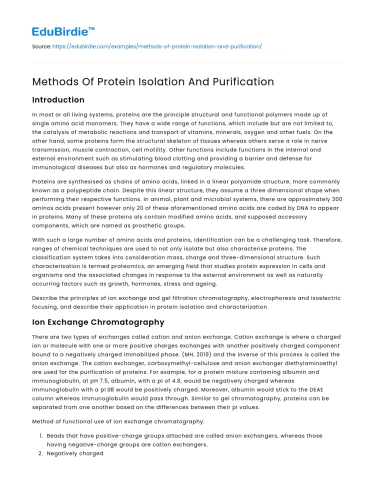Introduction
In most or all living systems, proteins are the principle structural and functional polymers made up of single amino acid monomers. They have a wide range of functions, which include but are not limited to, the catalysis of metabolic reactions and transport of vitamins, minerals, oxygen and other fuels. On the other hand, some proteins form the structural skeleton of tissues whereas others serve a role in nerve transmission, muscle contraction, cell motility. Other functions include functions in the internal and external environment such as stimulating blood clotting and providing a barrier and defense for immunological diseases but also as hormones and regulatory molecules.
Proteins are synthesised as chains of amino acids, linked in a linear polyamide structure, more commonly known as a polypeptide chain. Despite this linear structure, they assume a three dimensional shape when performing their respective functions. In animal, plant and microbial systems, there are approximately 300 aminos acids present however only 20 of these aforementioned amino acids are coded by DNA to appear in proteins. Many of these proteins als contain modified amino acids, and supposed accessory components, which are named as prosthetic groups.
Save your time!
We can take care of your essay
- Proper editing and formatting
- Free revision, title page, and bibliography
- Flexible prices and money-back guarantee
With such a large number of amino acids and proteins, identification can be a challenging task. Therefore, ranges of chemical techniques are used to not only isolate but also characterise proteins. The classification system takes into consideration mass, charge and three-dimensional structure. Such characterisation is termed proteomics, an emerging field that studies protein expression in cells and organisms and the associated changes in response to the external environment as well as naturally occurring factors such as growth, hormones, stress and ageing.
Describe the principles of ion exchange and gel filtration chromatography, electrophoresis and isoelectric focusing, and describe their application in protein isolation and characterization
Ion Exchange Chromatography
There are two types of exchanges called cation and anion exchange. Cation exchange is where a charged ion or molecule with one or more positive charges exchanges with another positively charged component bound to a negatively charged immobilized phase. (MH, 2019) and the inverse of this process is called the anion exchange. The cation exchanger, carboxymethyl-cellulose and anion exchanger diethylaminoethyl are used for the purification of proteins. For example, for a protein mixture containing albumin and immunoglobulin, at pH 7.5, albumin, with a pI of 4.8, would be negatively charged whereas immunoglobulin with a pI ∼8 would be positively charged. Moreover, albumin would stick to the DEAE column whereas immunoglobulin would pass through. Similar to gel chromatography, proteins can be separated from one another based on the differences between their pI values.
Method of functional use of ion exchange chromatography:
- Beads that have positive-charge groups attached are called anion exchangers, whereas those having negative-charge groups are cation exchangers.
- Negatively charged protein binds to positively charged beads, and positively charged protein flows through the column. (MH, 2019)
Gel Filtration Chromatography
Gel filtration, or gel-permeation, chromatography uses a column of insoluble but highly hydrated polymers such as dextrans, agarose, or polyacrylamide. Gel-filtration chromatography depends on the differential migration of dissolved solutes through gels that have pores of defined sizes. This technique is frequently used for protein purification and for desalting protein solutions. Figure 2.13 describes the principle of gel filtration. There are commercially available gels made from carbohydrate polymer beads designated as dextran (Sephadex series), polyacrylamide (Bio-Gel P series), and agarose (Sepharose series), respectively. The gels vary in pore size, and one can chose the gel filtration materials according to the molecular weight fractionation range desired.
Method of functional use of ion exchange chromatography
Proteins with different molecular sizes are separated by gel filtration based on their relative size. The smaller the protein, the more readily it exchanges into polymer beads, whereas larger proteins may be completely excluded. Larger molecules flow more rapidly through this column, leading to fractionation on the basis of molecular size. The chromatogram on the right shows a theoretical fractionation of three proteins, Pr1-Pr3 of decreasing molecular weight.
Electrophoresis
Iso-Electric Focusing
Isoelectric focusing (IEF) is used for to separate proteins on the basis of their pI by conducting electrophoresis in a microchannel or gel containing a pH gradient. A protein applied to the system will be either positively or negatively charged, depending on its amino acid composition and the ambient pH. Upon application of a current, the protein will move towards either the anode or cathode until it encounters that part of the system that corresponds to its pI, where the protein has no charge and will cease to migrate. IEF is used in conjunction with SDS-PAGE for two-dimensional gel electrophoresis (Figure 2.16). This technique is particularly useful for the fractionation of complex mixtures of proteins for proteomic analysis (below).
Mass Spectrometry
Mass Spectrometry is used to measure the molecular weight of proteins and also to detect post translational modifications of proteins and peptide chains in proteomic research. Matrix Assisted Laser Desorption Ionization, or MALDI, is an especially sensitive and powerful mass spectrometry technique to characterise biomolecules, with particular respect to identifying proteins.
Method of functional use of MALDI Mass Spectrometry:
- A protein sample is distributed in a large amount of excess matrix material. This will strongly absorb the incident light.
- Irradiation by a short pulse occurs and the protein is ionised and then desorbed from the matrix
- The ionised protein molecules are then exposed to a vacuum where a voltage gradient is active and these molecules accelerate at a rate that is dependent on their mass to charge ratio
- Each molecule reaches the detector at a specific time (known as the time of flight) that can be directly correlated to its respective molecular mass.
Works Cited
- MH, B. J. (2019). Medical BioChemistry






 Stuck on your essay?
Stuck on your essay?

